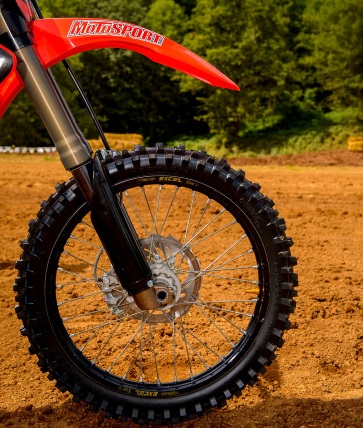
Fork oil and shock oil, or suspension fluid, keep your dirt bike running smoothly with the best possible handling even when needing additional tweaks to the suspension.
Turn those compression and rebound clickers all you want but if you haven't changed the suspension oil in some time you won't get any more fine tuning out of the forks and shock. Like motor oil, eventually the fork oil and shock oil (different lubricants and should not be confused) break down resulting in pretty crappy handling. Fortunately, like other fluids that keep your dirt bike running its best, suspension oil doesn't need changing often, but unfortunately tends to fall on the wayside.
As a general rule suspension fluid needs changing every 20 hours. This of course depends on manufacturer's recommendations specific to the make and model of your dirt bike as well as the type of riding. Hard, aggressive riding on top level Motocross tracks certainly demand more changes to the suspension fluid than cruises along easy trails.
What is Suspension Fluid?
But before continuing, lets breakdown (for the new rider and maybe veteran) all the terms that encompass suspension fluid because lots of terms exist and mean the same thing.
Suspension oil means the same thing as suspension fluid but the common term usually heard around the pits is suspension fluid. Don't worry, using suspension oil won't get you punted. Fork oil and shock oil make up the suspension fluid but do not consist of the same thing. Fork oil obviously goes in the forks and has a different viscosity than the shock oil which lubricates the shock located beneath the seat below the subframe.
That is the shock reservoir not a bomb
That grenade looking thing off to the side of the shock (piggy-back style) is the shock reservoir and contains a bladder that holds nitrogen which prevents aeration, enables consistent compression and rebound (tunable resistance against the oil in the shock), and helps keep the shock oil temperature in check by allowing extra oil capacity thereby increasing the service life.
Differences between Fork Oil and Shock Oil
It all comes from the ground or lab depending on your preference but the big difference between the oil that lubricates the forks and that which lubricates the shock comes in the viscosity (thickness) and weight. For example, Maxima Racing Fork Fluid brings 85-150 weight fork oil while the Maxima Shock Fluid has 75-390 weight. Interpret the weight just as you would regular 10w-40 motor oil.
Rear shock on a dirt bike
Before you add those to your cart, check the owner's manual for the proper fork oil and shock oil specific to the make and model of your dirt bike.
Forget the Hours
Don't let the sub headline fool you. We don't advocate forgetting the hours but since we too tend to either forget to keep track of the hours, lose track of the hours or just wing it. Admit it, you probably just wing it. At any rate, if you totally disregard the service intervals or have forgotten to keep track of time, once the suspension feels soft you know to change the suspension fluid which means both the fork oil and shock oil. Like the chain and sprockets, change both together not one or the other.
Hazards of Riding on Old Suspension Fluid
Riding on old suspension fluid of course affects the handling but continually waiting until the oil has passed its due date can wear out the seals faster. Changing the fork and shock seals* takes a good afternoon in the garage and eventually no matter how fastidious you get with record keep you will eventually have to replace the seals.
Front suspension on a dirt bike - a.k.a. the forks
However, routinely changing the fork and shock oil prevents faster wear and tear on the seals saving you money and keeping you riding longer. Seeing a geyser of suspension fluid spilling down your forks just prior to heading out not only ruins the ride day but pretty much ruins your whole day.
If you have never changed the seals in the suspension we can help get you started with the fork seals, a far easier task than replacing the shock seals which require special tools and a lot of mechanical know-how which means a strong suggestion to see a professional for the shock seals.
*Most riders probably can only change the spring and adjust preload, clicker settings and sag on the rear shock so finding a trusted mechanic for new seals and an oil change presents the better choice especially when handling that nitrogen-charged bladder.












